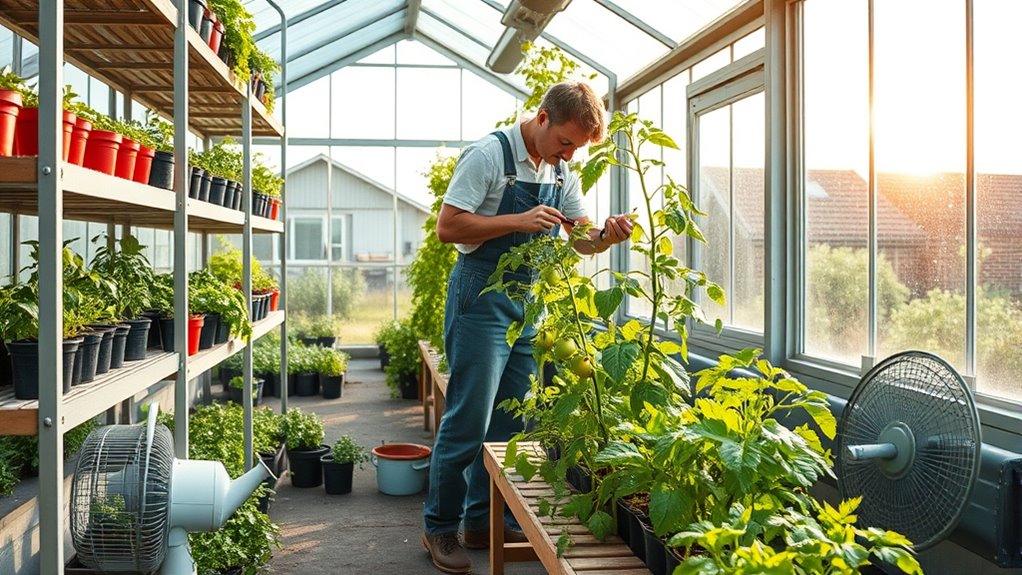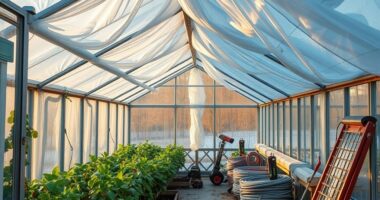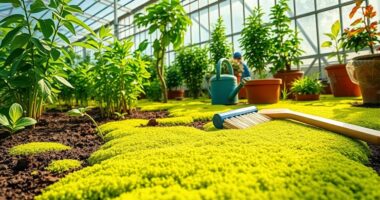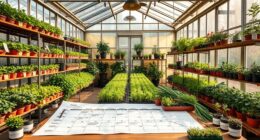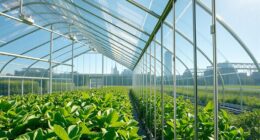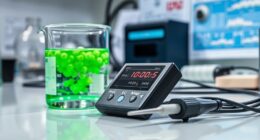To keep your greenhouse running smoothly, you should regularly inspect and clean ventilation systems, check structural components for damage, clean and maintain glazing materials, monitor humidity levels, and guarantee irrigation systems work correctly. Managing pests and diseases promptly, organizing and sanitizing your growing areas, inspecting electrical wiring, and scheduling seasonal checks are also vital. Staying on top of these tasks will protect your plants and prolong your greenhouse’s lifespan—keep going to discover more essential tips.
Key Takeaways
- Regularly inspect and clean ventilation systems, fans, and filters to ensure proper airflow and climate control.
- Check and repair structural components and glazing to prevent damage and maintain light transmission.
- Monitor and manage humidity and temperature levels using gauges, adjusting ventilation and heating as needed.
- Inspect for pests, diseases, and plant health issues, applying organic controls and removing affected plants promptly.
- Maintain equipment, irrigation systems, and record-keeping routines to ensure optimal greenhouse operation.
Inspect and Clean Ventilation Systems
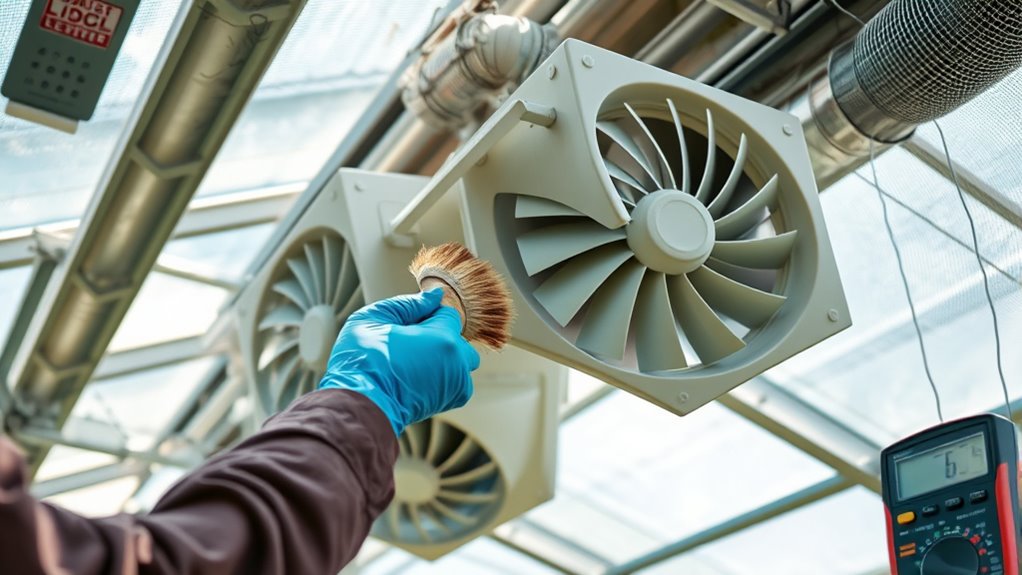
Regularly inspecting and cleaning your greenhouse ventilation systems is essential for maintaining ideal airflow and preventing the buildup of dust, mold, or debris. When you keep vents, fans, and filters clear, you enhance ventilation efficiency, guaranteeing fresh air circulates effectively. Properly maintained ventilation systems help regulate temperature and humidity, creating a healthier environment for your plants. By staying proactive with inspections and cleanings, you prevent airflow disruptions that could stress your crops or promote disease. Regular maintenance tasks also include checking for ventilation system issues such as worn components or loose connections that could affect performance. Incorporating automation technologies can further optimize ventilation management, ensuring consistent conditions. Embracing a maintenance routine helps you stay ahead of potential problems and supports robust plant growth. Consistent upkeep ensures your greenhouse remains well-ventilated, supporting optimal plant growth and climate control efficiency.
Check and Repair Structural Components
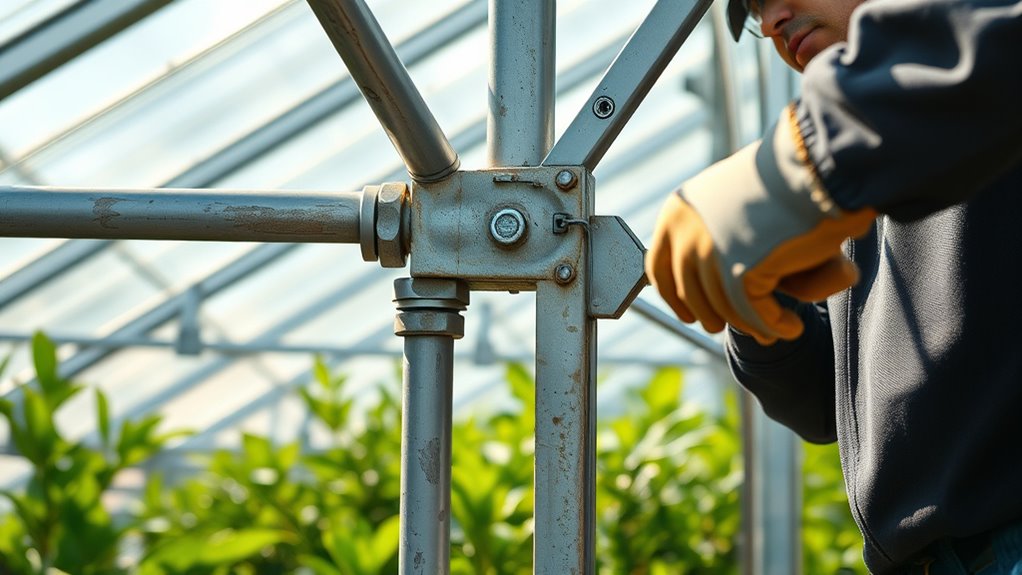
To guarantee your greenhouse remains safe and functional, you need to routinely check its structural components for damage or wear. Start by inspecting the frame for signs of rust, corrosion, or bending, which can compromise frame stability. Additionally, consider the benefits of regular maintenance to ensure long-term durability and safety. Confirm all joints, bolts, and fasteners are secure and free of rust or corrosion. Pay attention to any cracks or warping in the supporting beams, as these affect the structural integrity. If you notice loose or damaged parts, repair or replace them immediately to prevent further deterioration. Regularly evaluating these components helps maintain the overall stability of your greenhouse, keeping it safe during storms or heavy winds.
Clean and Maintain Glazing Materials
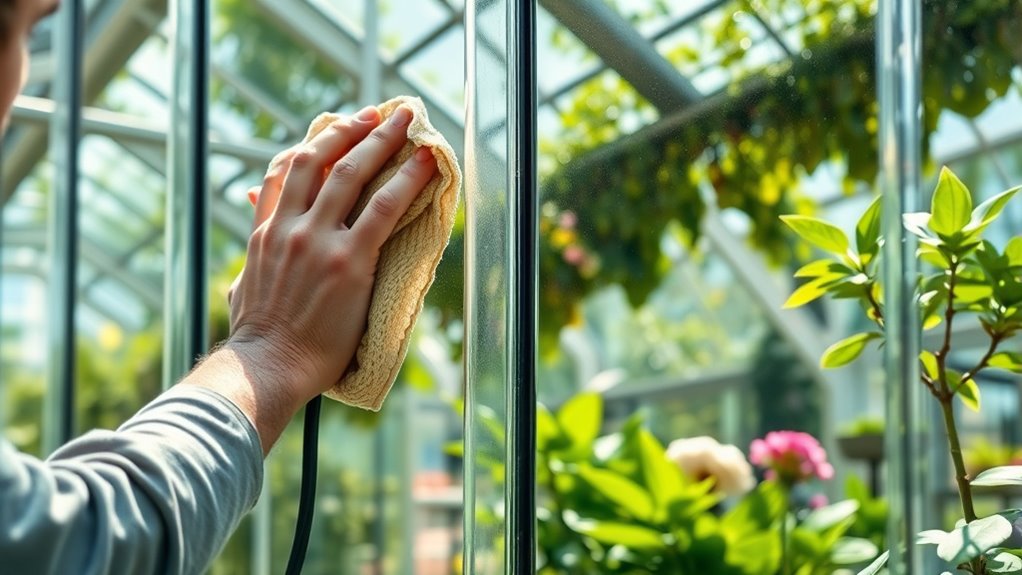
To keep your greenhouse productive, you need to regularly clear debris from the glazing materials. This helps maintain ideal light transmission and prevents blockages. Additionally, inspecting for damage ensures your glazing remains secure and effective. Regular cleaning and inspection can also extend the lifespan of your glazing materials and ensure optimal conditions for your plants maintaining proper illumination. Staying on top of glazing maintenance can help prevent costly repairs and ensure your greenhouse continues to thrive. Incorporating cookie management into your routine can help you stay refreshed and focused during long gardening sessions.
Clear Debris Regularly
Keeping glazing materials clean is essential for maximizing your greenhouse’s efficiency. Regularly removing garden debris and fallen leaves prevents buildup that can block sunlight and reduce heat transmission. Essential oils can be used in cleaning solutions to help inhibit mold and algae growth on glazing surfaces. Use a soft brush or cloth to gently clean the surfaces, ensuring you don’t scratch the glazing. Clear away any debris from the roof, sides, and vents to avoid obstructions that could affect airflow or cause damage during storms. If you notice stubborn dirt or algae, consider a gentle cleaning solution safe for your glazing material. Regular maintenance, including greenhouse upkeep, is crucial for preventing long-term issues and keeping your plants healthy. Staying on top of debris removal keeps your greenhouse well-lit and maintains ideal growing conditions. Incorporating regular inspections into your routine helps identify potential problems early and maintain a healthy environment for your plants. Consistently monitoring AI security measures can help prevent potential vulnerabilities that might compromise your greenhouse technology. Make this a routine task, especially after storms or heavy winds, to ensure your greenhouse stays clean and functional year-round.
Inspect for Damage
After clearing debris from your greenhouse, it’s important to inspect the glazing materials for any signs of damage. This damage assessment helps guarantee your structure maintains its structural integrity and continues to provide ideal conditions for plants. Look for cracks, holes, or warping that could compromise sunlight transmission or insulation. Regular inspections prevent small issues from worsening. Incorporating energy-efficient designs can also influence maintenance needs and costs over time. Using automation can assist in monitoring these conditions more efficiently. Incorporating grocery savings strategies can help offset maintenance costs over time. Understanding industry transformations like AI automation can also inform your maintenance approaches. Use this table as a guide:
| Damage Type | Indicators | Action Needed |
|---|---|---|
| Cracks | Visible cracks or splits | Repair or replace glazing panels |
| Holes | Punctures or missing sections | Seal or replace damaged areas |
| Warping | Bending or deformation | Reinforce or replace panels |
| Clouding/Fogging | Blurred or hazy appearance | Clean or replace glazing materials |
Conducting routine inspections is essential for early detection and maintenance. Timely damage assessment preserves your greenhouse’s durability, ensuring it remains a safe, effective environment for your plants.
Monitor and Control Humidity Levels

You should regularly check humidity gauges to keep track of moisture levels.
Adjust your ventilation settings as needed to prevent excess humidity or dryness.
Managing your watering schedule also helps maintain the ideal environment for your plants.
Use Humidity Gauges
Using humidity gauges is essential for maintaining ideal conditions inside your greenhouse. They help you accurately measure moisture levels, ensuring your plants stay healthy.
To get reliable readings, regularly calibrate your gauges according to the manufacturer’s instructions. Proper calibration prevents inaccurate measurements that could lead to over- or under-watering.
Place the gauges in representative areas of your greenhouse, away from direct sunlight or drafts, to get precise readings.
Consistently monitoring humidity levels with these gauges allows you to make informed adjustments, creating a stable environment for your plants.
Keep track of your measurements over time to spot trends and address issues proactively.
Adjust Ventilation Settings
Monitoring and adjusting your greenhouse’s ventilation settings is crucial for maintaining ideal humidity levels. Proper airflow management ensures ventilation efficiency, preventing excess moisture buildup. To enhance, regularly check your ventilation components like fans and vents, adjusting their settings based on humidity readings. Enhancing airflow improves moisture removal and stabilizes conditions.
| Ventilation Type | Ideal Settings | Tips for Adjustment |
|---|---|---|
| Exhaust Fans | High during humid days | Increase speed if humidity rises |
| Intake Vents | Open wider during dry periods | Adjust based on airflow needs |
| Ceiling Vents | Open gradually | Balance with exhaust fans for air circulation |
| Side Vents | Partially open for airflow | Use with fans for better efficiency |
| Passive Vents | Keep open consistently | Ensure no blockages for optimal flow |
Manage Watering Schedule
Have you ever wondered how precise watering can prevent excess humidity in your greenhouse? By carefully managing your watering cycles, you control moisture levels effectively.
Overwatering increases humidity, which can lead to mold and plant diseases, so it’s vital to water only when necessary. Use a moisture meter or check the soil regularly to determine when your plants need water.
Adjust your schedule based on seasonal changes and plant requirements. Consistent monitoring ensures your plants receive adequate hydration without creating a humid environment.
Proper watering not only promotes healthy growth but also helps maintain ideal humidity levels. Remember, balancing watering frequency and volume is key to preventing excess moisture that could compromise your greenhouse’s environment.
Inspect and Maintain Irrigation Systems
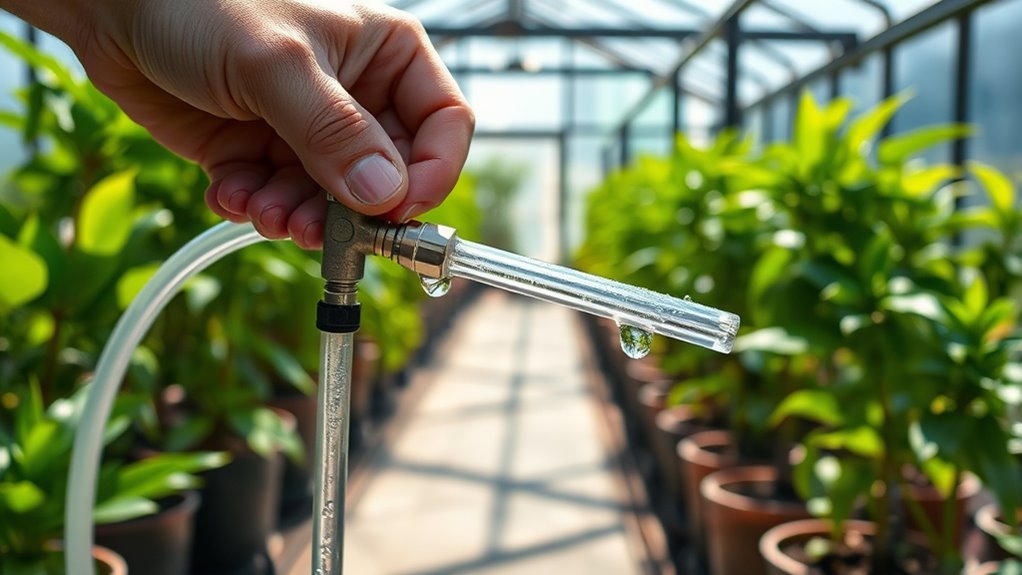
Regularly inspecting and maintaining your irrigation system is essential to guarantee your greenhouse receives consistent, efficient watering.
Consistent irrigation maintenance ensures your greenhouse receives efficient, reliable watering.
Check your drip emitters regularly to ensure they aren’t clogged or damaged, preventing uneven watering.
Clean or replace water filters to keep debris from clogging lines and emitters.
Inspect the entire system for leaks or blockages that could reduce water flow.
Finally, verify that pressure regulators are functioning correctly to maintain ideal water pressure.
Here are four key tasks to focus on:
- Examine drip emitters for clogs or damage
- Clean or replace water filters
- Detect and fix leaks or blockages
- Test pressure regulators for proper operation
Test and Replace Heating Equipment

How can you guarantee your greenhouse stays warm enough during cold weather? Regularly testing thermostats is essential. Check that your heating equipment responds accurately by verifying thermostat readings against a reliable thermometer.
If a thermostat is faulty or inconsistent, it may cause temperature fluctuations that harm your plants. When testing thermostats, look for signs of wear or damage, such as corrosion or inaccurate readings. If you find issues, replace thermostats promptly to maintain proper heat levels.
Upgrading to newer, more reliable thermostats can also improve temperature control. Always follow the manufacturer’s instructions when replacing thermostats, ensuring secure connections.
Maintaining your heating equipment and verifying the thermostats are functioning correctly helps keep your greenhouse environment stable and your plants healthy during cold months.
Manage Pests and Diseases Regularly
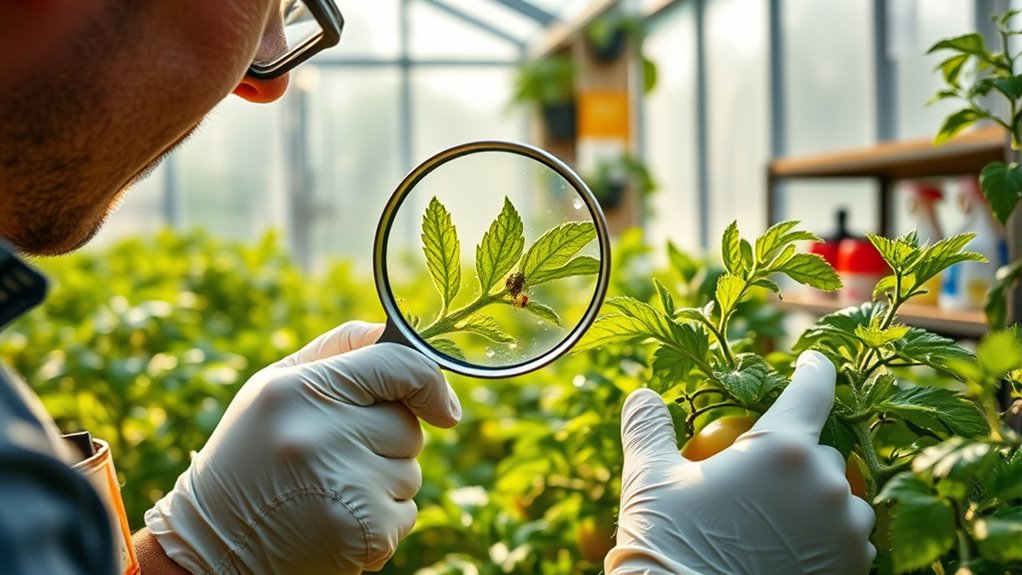
You need to establish a regular inspection routine to catch pests and diseases early.
Using natural pest deterrents can keep problems under control without harmful chemicals.
Consistent monitoring and prevention are key to maintaining a healthy greenhouse environment.
Regular Inspection Routine
Inspecting your greenhouse frequently is essential to catching pests and diseases early before they spread. Regular inspections help you monitor plant growth and identify issues promptly. During each visit, look for signs like discolored leaves, holes, or mold. Focus on areas where pests hide and inspect new seedlings carefully, considering seed selection to prevent introducing problems.
To streamline your routine, follow these steps:
- Check all plant surfaces and soil for pests or mold.
- Examine the undersides of leaves for eggs or larvae.
- Review the health of newly planted seeds and seedlings.
- Note any unusual growth patterns or damage for quick action.
Consistent inspection allows you to maintain healthy plant growth and prevent minor issues from escalating, keeping your greenhouse productive and pest-free.
Natural Pest Deterrents
Implementing natural pest deterrents is an effective way to manage pests and diseases without relying on chemical treatments. You can start by using companion planting, which involves placing certain plants together to repel pests naturally.
For example, marigolds deter nematodes, while basil repels aphids. Additionally, natural repellents like neem oil or garlic sprays can keep insects at bay without harming your plants. Regularly applying these natural solutions helps prevent infestations before they become severe.
Incorporate companion planting into your greenhouse layout to create a pest-resistant environment. This approach not only reduces chemical use but also encourages beneficial insects that naturally control pests.
Consistent use of natural repellents and strategic plant pairings make your greenhouse healthier and more sustainable.
Organize and Sanitize Growing Areas

Maintaining a clean and organized growing area is essential for healthy plant development and pest prevention. An orderly space reduces disease spread and makes managing your greenhouse easier.
A tidy growing area promotes healthy plants and prevents pests effectively.
To keep things tidy:
- Regularly remove dead leaves and plant debris to prevent pest habitats.
- Sanitize tools and surfaces to eliminate pathogens.
- Organize seed storage to avoid mix-ups and monitor seed viability.
- Manage compost properly, turning and aerating it to prevent odors and pest attraction.
Proper compost management reduces pest issues and improves soil health.
Keeping seed storage areas clean ensures seeds stay viable and free from contamination.
Inspect Electrical Systems and Lighting

Regularly inspecting your electrical systems and lighting guarantees your greenhouse operates safely and efficiently. Start by checking all wiring for signs of wear, damage, or corrosion to ensure electrical safety. Test circuit breakers and fuses to confirm they’re functioning correctly, preventing potential hazards.
Examine lighting fixtures to verify they’re secure and free of dust or debris that could affect illumination. Lighting optimization is essential for healthy plant growth, so replace any burnt-out bulbs promptly and consider upgrading to energy-efficient LED lights if needed.
Also, inspect timers and control systems for proper operation, ensuring your lighting schedules are accurate. Regular checks like these help prevent electrical issues, improve energy use, and create a safer environment for both plants and personnel.
Schedule Seasonal Maintenance Checks
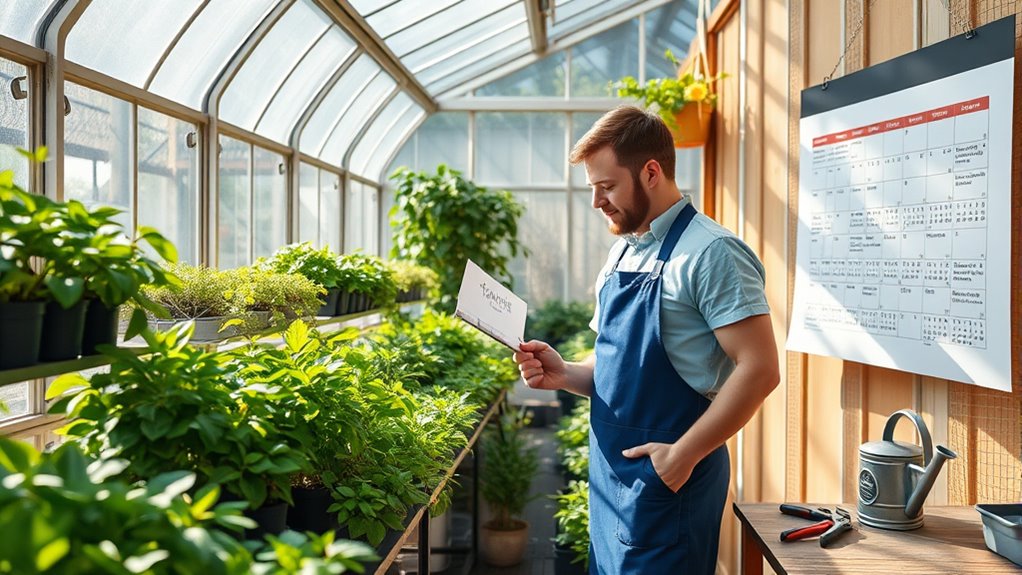
Scheduling seasonal maintenance checks is essential to keep your greenhouse running smoothly throughout the year. It helps prevent issues before they arise and guarantees ideal plant growth. During these checks, focus on tasks like seasonal pruning to promote healthy growth and prevent disease.
You should also review your plant rotation schedule to avoid soil depletion and pest buildup. Additionally, inspect and service ventilation systems and irrigation setups. Don’t forget to clean filters and replace worn parts to maintain efficiency.
Here are four key steps to include:
- Conduct a thorough inspection of structural components.
- Perform seasonal pruning to encourage healthy growth.
- Review and adjust plant rotation plans.
- Check and maintain ventilation and watering systems.
Sticking to this schedule keeps your greenhouse productive year-round.
Frequently Asked Questions
How Often Should I Perform Each Maintenance Task in My Greenhouse?
You should perform your watering schedule daily, ensuring plants get consistent moisture without overwatering. Check ventilation systems weekly to prevent mold and maintain airflow.
Regularly inspect your greenhouse for debris and pests. Adjust your watering routine based on plant needs and weather conditions.
Ventilation checks help regulate temperature and humidity. Staying on top of these tasks keeps your greenhouse healthy, productive, and prevents issues before they become serious.
What Tools Are Necessary for Effective Greenhouse Maintenance?
To maintain your greenhouse effectively, you need the right tools. Pruning shears are essential for trimming plants and keeping them healthy.
Soil testers help you monitor moisture and nutrient levels, ensuring ideal growth conditions.
Additionally, you’ll want a watering can, a trowel, and cleaning supplies.
With these tools, you can perform routine checks, prune effectively, and keep your greenhouse in top shape, promoting healthy and productive plants.
How Can I Prevent Pest Infestations During Maintenance?
Think of pest prevention as your greenhouse’s immune system. To keep pests at bay, practice integrated pest management—monitor regularly, remove infested plants, and encourage natural predators.
Seal cracks and doors to block entry points, and keep your greenhouse clean and dry to make it less inviting. These proactive steps help prevent infestations during maintenance, ensuring your plants stay healthy and thriving without resorting to harsh chemicals.
What Signs Indicate a Need for Urgent Repairs in My Greenhouse?
You should look out for signs of structural damage, like warped frames or broken glass, which indicate urgent repairs are needed.
Additionally, indications of water leaks, such as damp spots or mold, signal that immediate action is required to prevent further damage.
Addressing these issues promptly helps maintain your greenhouse’s integrity and ensures a healthy environment for your plants.
Don’t delay when you notice these signs to avoid costly repairs later.
Are There Seasonal Variations in Maintenance Requirements?
You might notice that maintenance needs change with the seasons. In warmer months, you’ll want to focus on seasonal pruning to keep plants healthy.
In colder months, climate adaptation becomes essential—like insulating and managing humidity. Regularly adjusting your routine based on the season ensures your greenhouse stays ideal year-round.
Stay attentive to these variations, and you’ll maintain a thriving environment no matter the time of year.
Conclusion
By tending to your greenhouse with consistent care, you’re nurturing a thriving oasis where plants flourish like a well-orchestrated symphony. Regular maintenance acts as the steady heartbeat, keeping everything in harmony. Think of it as tending a garden of possibilities—each task a seed for success. When you stay vigilant and proactive, your greenhouse becomes a lush, vibrant sanctuary where growth never stalls and beauty blooms endlessly.
